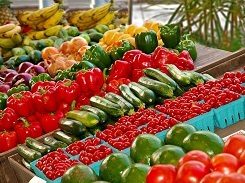Early 1900s Chinese Diet, Key To Rehnborg’s Phytonutrients Discovery
Plants produce nutrients as a defense mechanism to protect themselves from the expressed dangers and hazards in their ecological surroundings. These nutrients that plants produce are known as phytonutrients. People, when eating plants or plant based products, consume these nutrients as phytonutrients and they are thought to provide for people benefits similar to those they provide to the plants producing them.
In 1934 Carl F. Rehnborg started his supplement company. The company was renamed Nutrilite™ in 1939. Carl started his company based on the knowledge he acquired from the observations and experiments he carried out while studying the Chinese and their diet during his travels in China. He discovered the principle of phytonutrients which, at the time, he called “associated food factors”.
What are the key ingredients Nutrilite™ provides in their supplements?
Nutrilite™ supplements are made by combining the vitamins, minerals, and phytonutrients from over 170 plants. The phytonutrient component of ingredients have been included in Nutrilite’s™ supplements since the company’s beginning.
While supplementing with these important nutrients, it is of great importance to properly enrich your diet with the same nutrients. Phytonutrients are strongly related to the colors of plants. The next time you head to the grocery store or the local fruit and vegetable stand, take particular notice of the many colors on display. The main colors you see (purple, orange/yellow, red, green, white) are linked to the phytonutrients contained within the respective plant (fruit or vegetable) and each color is tied to a specific range of health benefits. To get a broad spectrum of these protective benefits, simply be sure to eat a variety from across the color palette of both fruits and vegetables.
5 Colors Each Day, For Health

When it comes to getting a wide range of benefits from the nutrients plants can offer, Nutrilite™ likes to say, “Five colors a day is the optimal way”. Those who carefully choose their food to include the five colors are choosing a diet that has the potential to benefit their whole body; from the head to the arms, heart, organs, body systems, legs, feet and more.
There are five main health categories associated with the phytonutrients found in the five main colors of plants. These five main health categories are brain health, vision health, heart health, cellular health and bone & joint health. Below you can see these categories with a list of some of the foods you can include in your diet for their nutritional benefit to your health.
5 COLORS A DAY
BRAIN
VISION
HEART
CELLS
BONES – JOINTS
BRAIN
PURPLE FRUITS & VEGETABLES – BRAIN HEALTH
The key phytonutrients related to brain health are found in purple fruits and vegetables. These phytonutrients are quercetin, resveratrol, ellagic acid, and many different types of anthocyanidins and procyanidins.
WHAT TO EAT
Grapes, blueberries, boysenberries, eggplant, purple sweet potatoes, plums, beets, and blackberries
VISION
ORANGE & YELLOW FRUITS & VEGETABLES – VISION HEALTH
The key phytonutrients related to vision health are found in orange and yellow fruits and vegetables. These phytonutrients are beta carotene, alpha carotene, beta-cryptoxanthin, lutein, zeaxanthin, quercetin, and hesperidin.
WHAT TO EAT
Pineapple, lemons, passion fruit, oranges, cantaloupe, carrots, apricots, sweet potatoes, tangerines, squash, papaya, and corn
HEART
RED FRUITS & VEGETABLES – HEART HEALTH
The key phytonutrients related to heart health are found in red fruits and vegetables. These phytonutrients are lycopene, anthocyanidins, proanthocyanidins, beta carotene, and ellagic acid.
WHAT TO EAT
Apples, cranberries, watermelon, pink grapefruit, guava, pomegranate, radishes, raspberries, strawberries, cherries, and tomatoes
CELLS
GREEN FRUITS & VEGETABLES – CELLULAR HEALTH
The key phytonutrients related to cellular health are found in green fruits and vegetables. These phytonutrients are isothiocyanate, lutein, zeaxanthin, isoflavones, and EGCG, plus many more.
WHAT TO EAT
Kale, collard greens, spinach, green peppers, watercress, zucchini, broccoli, brussels sprouts, green beans, soybeans, and green tea
BONES – JOINTS
WHITE FRUITS & VEGETABLES – BONE & JOINT HEALTH
The key phytonutrients related to bone and joint health are found in white fruits and vegetables. These phytonutrients are EGCG, allicin, isothiocyanate, quercetin, and anthocyanidins.
WHAT TO EAT
Turnips, onions, mushrooms, horseradish, white kidney beans, parsnips, garlic, cauliflower, black-eyed peas, and pears
Eat your five colors daily and if you are taking any Nutrilite™ supplements that include phytonutrients, you can know you are assisting your diet with a supplement that includes these same nutrients. Eating and supplementing in this manner is sure to give your body the basic, healthy nutrition it thrives on.
We’ve all heard, “An apple a day keeps the doctor away“, but perhaps a more rounded approach is to practice five colors a day as the optimal way.
The statements in this blog post have not been evaluated by the Food and Drug Administration. This product is not intended to diagnose, treat, cure, or prevent any disease. Consult advice when making your health, diet and diet supplement decisions.

